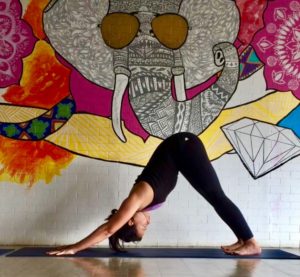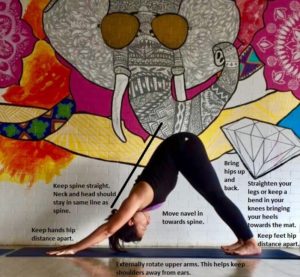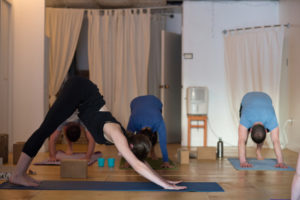
Welcome to our new series! Each month we will be highlighting a different yoga pose.
See what each pose does for your body, mind and how it could deepen your yoga practice.
This month features a pose you likely experience several times during a yoga class.
Find out about Downward Dog: benefits, cues, modifications, variations, and contraindications!
Downward Dog (Adho Mukha Svanasana)
Pronunciation: AH-doh MOO-kah shvah-NAHS-anna
- Adho = Downward
- Mukha = Face
- Svana = Dog
A Pose of Integration + Balance
Downward Dog is a foundational yoga pose—it strengthens and stretches your body from head to toe.
It is often used as a transitional pose or a resting pose.
As your body settles into the first downward dog of class, you are encouraged to peddle out your feet and/or bend your knees. As class progresses, the warmth of your body allows you to deepen into your downward dog position.
Disclaimer: If you have any medical concerns then talk with your doctor before practicing yoga. Practice within your own limits.
Benefits of Downward Dog:
- Can help relieve back pain
- Elongates the spine
- Allows you to tune into your breath
- Improves digestion
- Strengthens the legs, arms, and shoulders
- Calms the nervous system
- In inversions, the heart is higher than the head. The flow of blood to the brain can calm the nervous system relieving stress.
 Cues:
Cues:
- Bring your body into a tabletop position.
- Curl your toes under.
- Straighten your legs lifting your hips up and back.
- Spread your fingers wide and press into the thumbs and the index finger.
- Rotate the upper arms outward, so the eyes of the elbows roll slightly forward.
- Imagine you are trying to open up a pickle jar towards each outside edge of your mat.
- Keep the shoulders relaxed and the shoulder blades moving toward the pelvis.
- Lengthen through the arms and spine, creating a straight line of energy from the wrists to the pelvis.
- Make sure your heel is behind the 2nd and 3rd toes.
- Stretch through the legs and walk the heels from side to side to deepen into the stretch moving the heels toward the floor. You can keep your knees bent if you prefer.
Modifications:
- You can slightly bend your knees keeping your heels and tailbone lifted. Ensure your spine remains straight.
- Stand facing a wall. Bend at the hips maintaining a straight spine and press your hands into the wall.
- Place a block between your thighs. This helps to develop leg strength and proper alignment in this pose.
- Place knees down on your mat.
- Place a block under your head to relieve any stress on the neck.
Variations:
- Keep one leg raised into the air. Keep the raised foot active.
- If you wish, you can bend the knee of the raised leg and make circles with the knee in one direction. Reverse the direction about several rotations.
- Practice with your forearms on the floor. The forearms should be parallel to one another.
Contraindications:
- You should modify the pose if you have wrist or shoulder pain.

- If you have wrist pain, practicing with your forearms on the floor may help alleviate the pain.
- This is considered a mild inversion because your heart is higher than your head in this pose.
- You should not practice inversions, such as downward dog, if you have:
- carpal tunnel syndrome
- late-term pregnancy
- high blood pressure or related issues
- an injury to the back, arms, or shoulders
- If you are unsure on whether or not you should practice this pose, please contact a medical professional.
- You should not practice inversions, such as downward dog, if you have:



